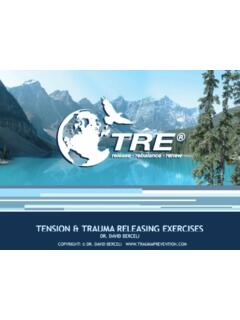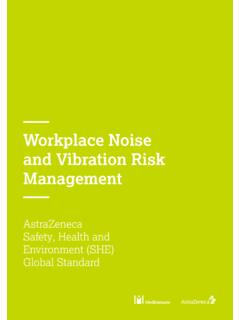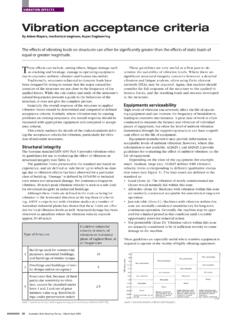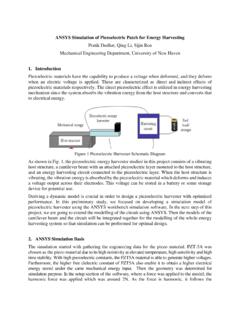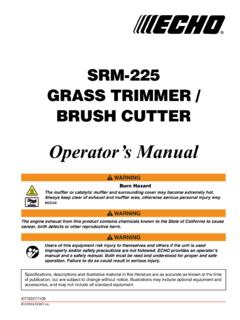Transcription of ELEMENTS OF ERGONOMICS PROGRAMS
1 CENTERS FOR DISEASE CONTROLAND PREVENTIONCENTERSFORDISEASECONTROLANDPRE VENTIONP ublic Health ServiceCenters for Disease Control and DEPARTMENT OF HEALTH AND HUMAN Institute for Occupational Safety and HealthNationalInstituteforOccupationalSa fetyandHealthDEPARTMENTOFHEALTH&HUMANSER VICESUSADEPARTMENTOFHEALTH& Institute forOccupational Safety and HealthIOSHA Primer basedon WorkplaceEvaluations ofMusculoskeletalDisordersELEMENTS OFERGONOMICSPROGRAMSA Pathway to Controlling Work-RelatedMusculoskeletal Disorders (WMSDs)LOOKING FORSIGNS OF WMSDsLOOKING FORSIGNS OF WMSDsSETTING THESTAGE FOR ACTIONSETTING THESTAGE FOR ACTIONTRAINING BUILDINGIN-HOUSE EXPERTISETRAINING BUILDINGIN-HOUSE EXPERTISEGATHERING AND EXAMININGEVIDENCE OF WMSDsGATHERING AND EXAMININGEVIDENCE OF WMSDsDEVELOPING CONTROLSESTABLISHING HEALTHCARE MANAGEMENTESTABLISHING HEALTHCARE MANAGEMENTCREATING A PROACTIVEERGONOMICS PROGRAMCREATING A PROACTIVEERGONOMICS PROGRAMCues and tip-offsto problemsCues and tip-offsto problemsManagement commitmentand employee rolesManagement commitmentand employee rolesOptions for reducing risks andevaluating their effectivenessOptions for reducing
2 Risks andevaluating their effectivenessHealth and risk factor datacollection and assessmentHealth and risk factor datacollection and assessmentDuties of health careproviders and othersDuties of health careproviders and othersAccent on preventionGeneral and specialized trainingneeds and access to resourcesGeneral and specialized trainingneeds and access to resourcesviiAwkward PosturesWrist DeviationsPoor Shoulder/Wrist PositionOverhead WorkTwisting and Carrying LoadsContact StressLifting Bulky LoadsHand - Arm VibrationWhole body VibrationFigure of selected risk factor conditions. (Illustrations adapted from UAW-GM Center for Health &Safety [1990]; Putz-Anderson V [1988]; Grant et al.)
3 [1995]; Canadian Center of Occupational Safety and Health [1988];American Meat Institute and Ergo Tech, Inc. [1990].21 Figure of some basic ways for controlling selected risk factor and tilt thecontainer for easieraccess and to reducebending and a turntablewith fixture to holdthe work; select a tool thatreduces wrist or pad edgesof guards, contain-ers, or work mechanicalassist devices forless stressful power toolswith anti-vibrationproperties. Use handlecoatings that suppressvibrations; increasecoefficient of friction toreduce force balancers,isolators anddamping materials toreduce vibrations at thesource or along trans-mission path.
4 Makedriving surface worker withplatform and usein-line tool to reduce and supporttool to reducestress on arm and conveyors toreduce twistingand eliminate lifting (Continued)Ye sNo (If NO, stop here)Have you had any pain or discomfort during the last year?If YES, carefully shade in area of the drawing which bothers you the Survey: ERGONOMICS ProgramJob NameHours worked/weekTime on THIS JobShiftDateyearsmonthsPlantDept #Other jobs you have done in the last year (for more than 2 weeks)(If more than 2 jobs, include those you worked on the most)Time on THIS JobTime on THIS JobJob NameJob NamemonthsweeksweeksmonthsPlantDept #PlantDept #Tray 4 A.
5 Symptoms Survey Form871 hour1 day1 week1 month6 months4. How many separate episodes have you had in the last year?5. What do you think caused the problem?6. Have you had this problem in the last 7 days?YesNoYe sN oYe sN o7. How would you rate this problem? (mark an X on the line)NOWNoneNoneWhen it is the WORST8. Have you had medical treatment for this problem?8a. If NO, why not?8a. If YES, where did you receive treatment?1. Company Medical2. Personal doctor3. OtherDid treatment help?9. How much time have you lost in the last year because of this problem?days10. How many days in the last year were you on restricted or light duty because of this problem?
6 Days11. Please comment on what you think would improve your symptomsTimes in past yearTimes in past yearTimes in past year(Complete a separate page for each area that bothers you)2. When did you first notice the problem?(month)(year)1. Please put a check by the words(s) that best describe your problemCheck Area:3. How long does each episode last? (Mark an X along the line)ShoulderElbow/ForearmHand/WristFing ersNeckUnbearableUnbearableLow BackThigh/KneeLow LegAnkle/FootUpper BackStiffnessLoss of ColorNumbness (asleep)AchingTinglingPainBurningWeaknes sSwellingCrampingOtherTray 4 A (Continued).88 Work SurfaceFootrest4" 10 Precision workLight workHeavy work28" 35"37" 43"34" 37"64564840322416800816243240 OccasionalextendedreachINCHESINCHES60"20 "40"13" 17"10"6" 12"7" Minimum8"2 12"14" 21"2 5 SEATED WORK:Primaryand secondaryareas for table top work surface height varies with the work performed:Precision work = 31 37 = 28 31 assembly = 21 28 and back rest heights should be adjustableas noted in chair requirements WORK:Boundaries for vertical reachesfor grasping WORK:Shelf heights to which a free-standing person can reach andplace a hand flat on a shelfshould not exceed 60 WORK.
7 Workbench heights should beabove elbow height for,just below elbow height for, and4 6 in. below elbow height worklight workheavy work*Adapted in part from Grandjean E [1982] (.London: Taylor & Francis Ltd.) and UAW-GM [1990] (MadisonHeights, Michigan: Center for Health & Safety).Fitting the Task to the Man: An Ergonomic ApproachUAW-GM ERGONOMICS 6 A. Recommended Workstation Measurements*21" 25"102










